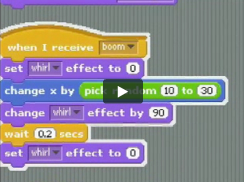Unfortunately, many students do not really know what computer science is when they choose careers. Some think it is about using computers. Others see the geeks that are portrayed in the media. The goal of the K-12 Educational initiatives are twofold. One is to integrate computer science concepts into traditional classrooms by allowing students to use programming languages to create animations of concepts in language arts, drama, science, or history. The second is to develop activities that are computer science specific, emphasizing the creative thought process in computer science apart from the computer work.
UCSB has efforts in both areas, with the most mature being outreach activities that use computer science activities to show the thought process. You can find existing outreach efforts at in the Outreach area. We're always looking for more volunteers!

Programming for Kids
- Alice, a development environment to easily create 3-D movies and games, that exposes junior high and high school students to the concepts of objects and programs in a simple, straight-forward, powerful, and exciting way.
- Scratch: a programming language for everyone. Create interactive stories, games, music and art. This is a 2-d environment in which it is easy to create and animate your own pictures. This can be used with elementary school students all the way through college students. There is an online repository of projects kids (and adults) have made.

Outreach Activities
- Scribbler Robot, a robot that can be programmed to drive a set route (carrying a pen) to draw a picture, respond to bumps and/or light changes, and/or play a song. This is appropriate for upper elementary students through high school.
- CS Unplugged, a set of computer-free activities signed to expose elementary school students to the thought process of computer science without a computer. Some of the activities are appropriate for older audiences.
- Pleo Dinosaur, very popular with young girls. You can program the very cute dinosaur's reaction to different stimuli or just play with it as-is.
- LEGO activity, inspired by this paper and adapted by Diana Franklin. These are binary programs that tell students how to build a LEGO creation. These are for junior high students and older, and they require the instructor to go through the first few "instructions" with the students. Once they "get it," they really enoy it. This is also used as a lab in an assembly programming class to teach the tie between binary encoding and the instructions, and the students absolutely love it.
- LEGO Mindstorm, programmable lego robotics.
- Count to 1023 on your fingers, adaptation by Diana Franklin of a CS Unplugged activity teaching students binary. This version is appropriate for a large audience, lecture-style presentation setting. Appropriate for upper elementary, junior high students, and even to teach binary in college.
- SciGirls - The new PBS Kids television series, SciGirls, features groups of middle school girls modeling authentic, girl-focused approaches to inquiry-based science and engineering projects. The SciGirls television series, website, and outreach initiatives emphasize current research on strategies, the SciGirls Seven, proven to increase girls’ engagement in STEM.

Local Outreach Efforts
- Girls Inc, non-profit organization dedicated to inspiring all girls to be strong, smart, and bold. With National Girls Inc. roots dating back to 1864, and local roots dating back to the 1950s, Girls Inc. has responded to the changing needs of girls through award-winning, innovative afterschool and summer educational enrichment programs and through public education efforts that empower girls to understand, value, and assert their rights. Girls Inc. programs for girls ages 4 ½ to 18 years old focus on science, math, and technology; economic and financial literacy; athletics; health and sexuality; culture and heritage; leadership and advocacy; and media literacy.
-
UCSB LEAPS - Let's Explore Applied
Physical Science has created three programs that engage UCSB scientists and engineering reseachers, graduate students, and undergraduates with K-12 teachers, their students, and our community.
The School for Scientific Thought, Saturday science courses for students grades 10-12.
After School Science Programs, programs at La Cumbre and Santa Barbara Junior Highs, and Cesar Chavez Charter and Cleveland Elementary Schools.
Family Science in the Community, evening science events held at La Colina, La Cumbre, Goleta Valley and Santa Barbara Junior High Schools. - Animal Tlatoque Summer Camp a program integrating animals, conservation, Mayan culture, and computing for middle school students.
- MESA Science & Technology Day - Workshops and contests for first-generation middle school and high school students across Santa Barbara County. We run a workshop on Scratch programming.
- iD Tech, running summer camps for 6-18 year olds on programming, game design, web development, and film. Local classes are held in Santa Catalina.
- code.or a new website pointing people to resources to learn programming for free